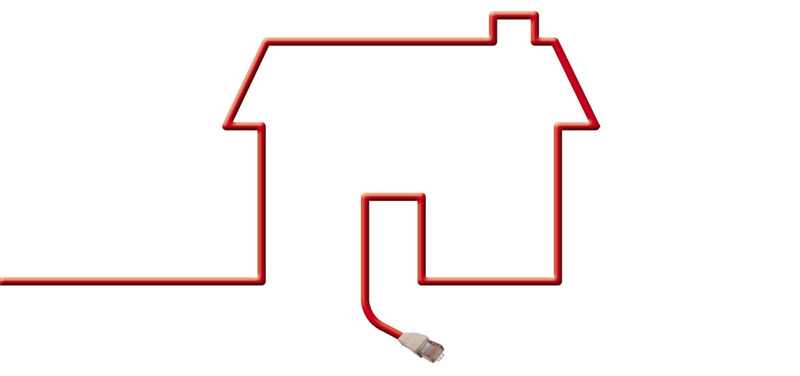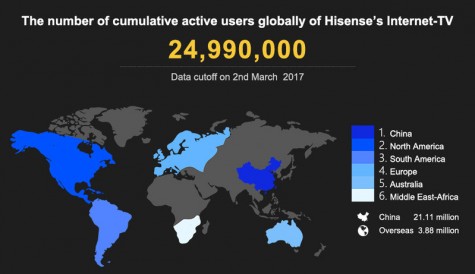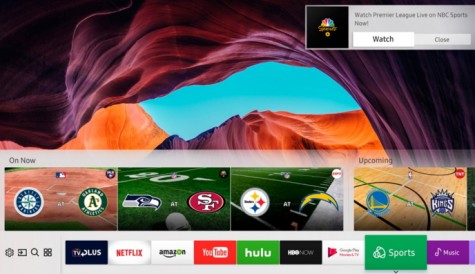
After more than 40 years of operation, DTVE is closing its doors and our website will no longer be updated daily. Thank you for all of your support.
Only connect – service providers and the connected home
Support for the connected home is something that pay TV service providers can no longer ignore in the face of competition from consumer electronics manufacturers and software providers. Stuart Thomson looks at recent developments.
 Whether they like it or not, service providers are now being forced to face up to the challenge of supporting the home network requirements of their subscribers. Having shied away from the responsibility for as long as they could, triple-play service providers now generally support WiFi. However, the growing demand to view content on iPads and other devices, as well as growth in home-produced media that can be viewed on multiple devices, means that service providers can no longer ignore the clamour for wider home-network support.
Whether they like it or not, service providers are now being forced to face up to the challenge of supporting the home network requirements of their subscribers. Having shied away from the responsibility for as long as they could, triple-play service providers now generally support WiFi. However, the growing demand to view content on iPads and other devices, as well as growth in home-produced media that can be viewed on multiple devices, means that service providers can no longer ignore the clamour for wider home-network support.
The need to support the connected home is something that is certainly a priority for industry technologists, with a wide range of suppliers devoting attention to this area.
“The reality is that if you look at what’s happening right now, service providers are getting calls related to home network issues,” says Pascal Portelli, senior vice-president, digital home at technology provider Technicolor.
This means that call centres are forced to provide some support for customers to connect retail devices to the network. For service providers, however, there are potential advantages to this. “The service providers’ approach is to try to support as wide a range as possible of devices,” says Portelli. “At the end of the day it’s what the end user wants and [for the service provider] it’s a way to avoid having to carry too much capex when the device could be purchased by consumers.”
Gateway devices
While the ability to deliver content to retail devices could enable operators to save capex, many of them are increasingly looking to deploy their own gateway devices, with significant processing power, to be at the heart of the connected home.
These devices are increasingly seen by operators willing to make the investment as a key tool to differentiate. For Charles Cheevers, chief technology officer, Europe and vice-president of product line management at cable technology provider Arris, one of the ways in which such providers can deliver something new is that by allowing the home gateway they provide to take the strain, they could theoretically allow users to leave their own PCs switched off while the home network remains up and running. Cheevers points out that intelligent next-generation gateways being deployed today have the same processing power as laptops had about a year ago.
There are a number of different approaches. Arris has developed a ‘headless’ gateway – i.e. a device without any display panel – which Cheevers says can help ensure a consistent user experience, particularly if service providers deploy multiple DVR devices. Some service providers – most notably UPC Broadband with its Horizon project – have on the other hand chosen to deploy ‘headed’ devices. In either case, the gateway is increasingly seen as key to the connected home managed by service providers.
“The service providers’ approach is to try to support as wide a range as possible of devices.”
Pascal Portelli, Technicolor
Some technologists also argue that investing in high-end consumer equipment can enable service providers to save money elsewhere. If one of the key applications that is driving demand for connected home support is to be able to view professional video on multiple devices (as well as to view over-the-top video), this has to date typically been supported from the headend rather than by using ‘home server’-type devices. Currently, says Technicolor’s Portelli, multi-device video is delivered direct from the internet to the device, which means that for live content there is a certain amount of wasted bandwidth as multiple streams of the same content find their way to different devices. “Where this is starting to change is with media gateways in the home that can help manage that delivery to multiple devices including real-time live broadcasts,” he says. “Now a certain number of operators are starting to deploy devices – media gateways – that can [enable] delivery to multiple devices with only one device making a request to the network.”
Portelli believes that advances in chipset development have reached a point where transcoding of video in the home – previously seen as too complex and expensive – is now a possibility. As innovation enhances the processing power of devices, so it begins to make sense to deliver content once for viewing on multiple devices, especially where bandwidth is in short supply. Portelli cites research by Technicolor that shows that a large number of users are interested in using tablet devices to complement rather than substitute the main screen in the home by using the former as a kind of advanced remote control. “There is a lot of interest in using [the tablet] as a second remote to display the EPG and to look at secondary channels in a way that’s better than picture-in-picture,” he says. Moreover, the research shows that many consumers would prefer a specific dedicated device – i.e. one supplied by the service provider – rather than a consumer device like an iPad, for this.
Alexander Sem, marketing manager, solution TV at Ericsson, also believes that the introduction of ‘companion devices’ – tablets that can be used to interface with the main TV screen in the home, could be supplied as a branded device by the service provider itself as well as offering the use of retail devices such as the iPad. Some larger operators including PCCW have already deployed such devices.
TV everywhere
The tablet, in its other capacity as a secondary viewing device, is also driving greater interest in viewing content outside the home. For the service provider this is where things become more complicated. Operators – especially in the US – have increasingly been giving attention to the ‘TV everywhere’ concept. Users can stop watching something on the main screen in their houses and then take up from where they left off on a tablet or mobile phone as they move around, with the right to view any content to which they subscribe, wherever they happen to be, by accessing that content on a server somewhere in ‘the cloud’. (An alternative approach is for the consumer to access his or her own home network remotely. A basic version of this approach has been delivered by the SlingBox and could be supported by the ‘SlingLoaded’ devices developed by EchoStar.)
There are some challenges to cloud-based ‘place-shifting’. Delivery of content from the cloud over third-party infrastructure could be subject to volume caps – increasingly seen as a highly problematic challenge. On the other hand, the alternative approach of taking content from a home server would also require significant upstream bandwidth to work seamlessly. Possible ways to support the latter approach (at least in part) could include the use of peer-to-peer technologies by service providers to enable video-on-demand services to be delivered to the viewer from multiple subscribers to the same service with the relevant assets available on their own hard drive-enabled devices in the home.
‘The cloud versus the home network’ (based on the multimedia gateway) is a key choice that operators must make, according to Yann Courqueux, chief marketing officer at technology provider Netgem, which recently launched nCloud, a platform designed to enable ‘home cloud’ networking based on a home server-type architecture. “Service providers have to make a choice between cloud-based on device-to-device home network-based services,” says Courqueux. He says that one of the most important determinants of choices made by service providers will be the need to protect the privacy of users. “This is where the home network becomes really strong,” he says. The case for the ‘home cloud’ (as against the ‘network cloud’) is strengthened on the grounds of cost, he says, for operators delivering live video services to multiple screens. However, network cloud-based delivery will be required for out-of-home consumption and possibly also for video-on-demand. Therefore, he says, a hybrid architecture will be best – but one that does as much as possible within the home. “Instead of a server-to-client or mesh-based device-to-device architecture, we have something where you have a server-to-client architecture in the home,” he says, with a gateway device acting as a proxy server in the home.
For Courqueux, the gateway model makes sense not only by saving bandwidth in the case of live video but because it is more scalable, with costs going up in line with the number of subscribers as against the need to invest in large data centres to serve customer from the cloud. Next-generation boxes will have transcoding capability built in, he says, enabling content to be delivered upstream to portable devices from a home server.
[icitspot id=”14830″ template=”box-story”]Whatever the merits of the home server, however, the ‘network’ cloud clearly still has a role to play. “I think the cloud is hugely important,” says Arris’s Cheevers, otherwise another advocate of the home gateway approach. “The gateway does RF to IP conversion and has to support a certain number of devices. The design of the gateway should be such that it functions without a hard disk in it and can work with the cloud-based delivery even of DVR content. Moving stuff to the cloud and off the home [network] is definitely happening and will prevail because it gives you an architecture that allows you to deliver to any devices from one architecture.”
Delivering functionality from the cloud, such as vital multi-screen elements including transcoding and content security, is seen as having clear advantages by Andy Salo, director of product marketing at video processing technology provider RGB Networks. According to Salo, operators in many cases have already invested in the infrastructure they require to prepare and distribute content in multiple formats to multiple devices, even if they haven’t switched on the relevant functions.
Range of formats
In the end, it would seem, a hybrid approach encompassing cloud-based and home server-based elements may well be the one that prevails. However content is delivered, the complexity of providing support inside and outside the home to multiple devices certainly means that service providers’ central support systems must be up to the task. According to Ericsson’s Sem, the key elements that those service providers need to put in place will include a device management system that can identify when users connect to a new device that’s connected to the network.
Sem argues that the biggest challenges facing service providers are the range of formats that they will need to support, and the rights issues surrounding the content itself. Rights have to be managed and content protected, while the growing use of adaptive bit-rate streaming – varying the bit-rate of the content according to the bandwidth that is available – means that a vastly greater number of copies of each piece of content must be prepared and stored. “It’s mostly about having a proper content management system that keeps track of the type of content you have and making sure it’s automated,” he says.
On the video processing side it is possible, he says, to transcode video in the cloud for distribution to multiple devices, but PCs and other devices in the home increasingly have the capability to transcode content as well.
Despite the advantages of putting functionality that requires significant processing power in the cloud, says Salo, there are certain things that it might make more sense to do in the home. One of these is providing storage to serve on-demand viewing. But even here, viewing content on-demand outside the home is more easily facilitated by a cloud-based system. “As a consumer you don’t need all the storage capacity in the home – you want content to be available any time so you can take it wherever you go. Mobility is a huge benefit of the cloud,” he says.
The big challenges facing service providers, he says, are maintaining security for the content and providing adequate reporting mechanisms so that advertising-based services become measurable.
On the security side, the need to manage secondary rights and make sure rules for viewing on a range of devices is followed means that the systems put in place by service providers must be ever-more sophisticated.
The need for efficient headend-based systems is made more acute by the proliferation of formats that must be supported thanks in large part to adaptive bit-rate streaming. While consensus on video codecs has largely coalesced around H.264, the development of adaptive bit-rate streaming has pushed in the opposite direction, with a split between the Apple HTTP Live Streaming, Adobe and Microsoft formats as well as the MPEG DASH standard initiative.
Content security
The key challenge for Netgem’s Courqueux is content security. “What’s working well at the moment is detection of devices and browsing, but what’s not working yet is the content protection piece. There is still a lot of fragmentation,” he says. “We need to be able to change conditional access to DRM and identify devices. You need to create a trusted domain – then you can send a key to the trusted device over a secure link.”
While it does not meet all the security requirements of service providers seeking to distribute content to multiple devices, DTCP IP allied with DLNA provides a good standards-based foundation, according to Christopher Schouten, senior director, marketing solutions at Irdeto. Additional measures will be necessary to allow users to share content in a DTCP IP-protected domain and to protect content on open devices including Android-based mobile devices and PCs.
Schouten says that protecting content that is delivered direct to a device from the cloud is probably the best approach in the absence of service providers deploying expensive new hardware such as Liberty Global’s Horizon gateway set-top device. Few operators, he suggests, are willing to invest so heavily in new consumer premises equipment. He suggests that the US UltraViolet initiative, the name given to the universal cloud-based rights authentication system proposed by the Digital Entertainment Content Ecosystem (DECE), could solve a number of problems. This provides a framework where rights to content held in multiple locations and view-able on multiple devices can be stored in the cloud. So far five DRM players have signed up. (Apple, along with Disney, remains outside the UltraViolet consortium, however).
Within the home, DLNA remains a key technology. For Technicolor’s Portelli, standards including DLNA can help simplify things for the service provider but only up to a point. “Standard technologies like DLNA help but they only go so far. Operators typically need more and more tools. DLNA has not been designed for someone in a call centre to look at devices in the home,” he says. “There needs to be another layer on top of that for operators not only to diagnose networks or set-tops but also to identify what those devices are.” While DLNA allows devices to share content, it does not specify how video files should be displayed, meaning that it is difficult to deliver a user-friendly multi-screen video service based on DLNA alone.
Remote management of devices in the home could be eased by emerging standards including TR-69. However, Portelli argues that other technology solutions will be required to give service providers the ability to diagnose and troubleshoot problems. “TR-69 helps but it doesn’t go all the way. It’s a nice tool to do software upgrades and so on but it’s not been designed for real-time diagnostics,” he says. According to Portelli, additional software solutions will be required to make all the different pieces come together. “We are putting a lot of emphasis on software. A lot of it is about how to make the software [elements] available on different devices in an open framework,” he says. “Our emphasis is to enable service providers to deploy the same services on different devices, and enable that on the fly.”
Given the complexity involved in getting this far, the extent to which pay TV service providers will ultimately want to go beyond connectivity and get involved in delivering a wider range of applications over the home network is open to debate. However, there may be a case for them to focus on those applications that, while not strictly related to TV content, are ‘entertainment-focused’ such as games and video conferencing. Beyond that of course is the prospectively lucrative realm of home automation and security and energy management. But whatever the future holds in terms of added-value services, supporting the connected home is clearly something they can no longer ignore.


